
Max Porter’s Lanny is published today. He shares five books about being a tree.
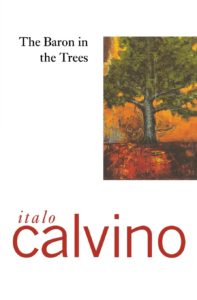
The Baron in the Trees by Italo Calvino
I’m a tree worshipper, as we all should be. I remember as a kid learning about religion and finding it funny and baffling that we needed to invent gods in the sky with beards and elaborate magical powers when we had actual gods stood in the earth right next to us, giving us the air we breathe, teaching us how to live.
I got a pissy review for my new book in the UK and the photo caption was ‘Porter goes full hippy’ and I thought yeah damn straight, you gas-guzzling oaf.
Anyway, this is the Calvino that warms my heart like no other, perhaps because I genuinely fantasize about escaping to the trees as Cosimo does. And I admire his Bartleby-esque giving of no fucks. He doesn’t want to come down, so he never does. I admire the spirit of play, and the stubbornness, and the visionary political bravado of his dream; The Republic of Arborea, a place for good humans. It’s a heartbreakingly gorgeous book.
Jane Ciabattari: Two questions. Is the fact the tree is a holm oak significant? And, how you think the narrator being the baron’s brother affects the story?
Max Porter: Well there’s a tendency for oak trees to want to take center stage in any story. And they’ve been houses, and chapels, and refuges. They invite climbing. A very inviting but bolshy tree, a holm oak. Like the harder, tougher, waxier big brother. They give me a strange feeling. The point I think about Cosimo stropping up into that tree is it’s their holm oak, a family tree, a site of family drama, sibling play and so on. Which is what’s so magnificent about the way he just walks straight into the next tree, and the next tree, away from the garden, into the bad world. A local idea, an intimate symbolic thing, from which he walks into global politics, big philosophy, love and danger and pure mad heroism. It’s such a fun book.
I don’t know how it affects the story that it’s narrated by the brother, but it’s one of the reasons I love it. The affection (and its branches; disapproval, concern, admiration, bemusement, hagiographical labor) for Cosimo is wonderful. The final pages when he describes the flight of his brother, I could weep just thinking about it.
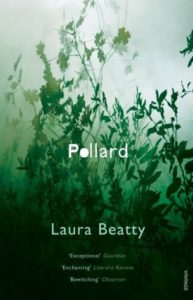
Pollard by Laura Beatty
Also about escaping to the woods, this is one of my favorite modern English novels, and one of my all-time favorite books about being alone (or not, as the case may be). It’s about Anne, trapped in her human skin, living in the woods. It’s about the tragic fact of a person not being able to be a tree. It’s a frightening book, and I suddenly realize how much I need to re-read it.
JC: In her evocation of fifteen-year-old Anne’s withdrawal into an isolated life in a wood, Beatty seems to call out for the loss of wilderness (she writes of “the slow suffocation of the trees” and some passages are narrated by a Chorus of Trees). What do you think she means by her title, which refers to a pruning method that cuts a tree back to the trunk, creating a uniform tree canopy, a forest altered by human hand?
MP: I suppose she wants to get at the fact that a natural wood, a wildwood, is not a thing we find on this planet very much any more. And good forestry, silviculture, the cutting of trees to care for them, to give them longevity, is an act of love, rather than harm, and we must live with trees not as if they are others, but as if they are our selves. In the pollarded tree we have an emblem of collaboration, of community, of endurance beyond using the tree for immediate human gain. I think of Pollard as a deeply pagan book, inasmuch as it is pointedly unromantic and deeply serious about what a human means to a tree, and vice versa.
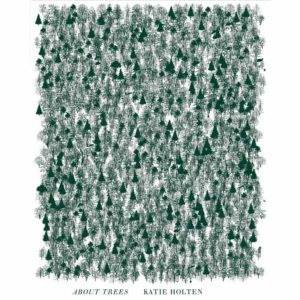
About Trees by Katie Holten
I consider this book to be a masterpiece. A radical anthology, not about but of, in, and around trees. It’s given me such joy, and introduced me to some remarkable artists and writers. It’s generous and experimental and moves as woodland does, so it’s different every time I encounter it. Her tree alphabet is a gift to the printed world.
JC: Her tree alphabet replaces each of the 26 letters of the alphabet with a font, thetypeface she calls Trees. As Holten puts it in an interview, “About Trees is a book about trees written in trees. It’s a collection of texts about trees, about the notion of trees, and a constellation of tangential tree-related things….Each text becomes its own forest.” She includes work from Plato, Borges, Radiohead, Ursula Le Guin. What are your favorite passages, letters, trees?
MP: If I had to choose one, it would be the iconic Le Guin: “The Word for World is Forest.” I was also grateful to Katie Holten for pointing me towards Extinction Symbol first, and to some of the ways we might connect the poetic to the political, and how people have been at work on that project for a long, long time. Since before we used the alphabets we use now.
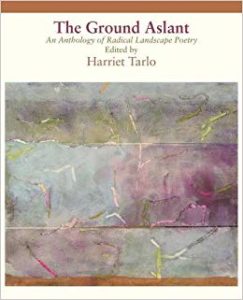
The Ground Aslant, Ed. by Harriet Tarlo
This is an anthology of landscape poetry by contemporary poets including some I knew and some I didn’t, and it has sent me off to discover poetry, and specifically radical eco-poetry, that has changed my idea of what language means now, in the Anthropocene. I read poetry every day of my life and feel that the poem and the tree are linked, are siblings, and I want to find the work that examines that relationship.
JC: There are sixteen poets in all, including Peter Larkin, Thomas A. Clark, Mark Goodwin, and Helen Macdonald, and each of them finds a way to show a small bit of landscape in a fresh manner. What makes their work “radical?”
MP: Much of the work is formally experimental, which I guess denotes radicalism, but I’m not a poetry expert and don’t perhaps recognize formal innovation as a scholar might, so I’m looking for radical insight, radical impact on me the reader, and for that I’d be looking for philosophical shock, or unexpected or unfamiliar linguistic innovation. And there is that on every page. Mostly it seems to me that the familiar relationship between human being and landscape from, say, pastoral poetry or nature writing or ecological theory is altered, expanded, dismantled, skewed, shot through with something I haven’t come across. And with a poet like Peter Larkin I find I’m listening to the work in a way much more like I listen to music, letting it sit a distance from me, barely understood but very busy, very alive, something not at all like reading a poem in a book and much more like the inexplicable back-of-the-brain unformed stuff that happens when you’re in contact with living things, or dreaming, or finding language failing you, and that feels pretty radical, when you come across work that does that. It feels like I’ve encountered this work, rather than read it. That’s what I’m after.
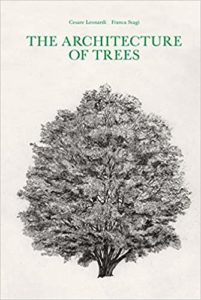
The Architecture of Trees by Cesare Leonardi and Franca Stagi
This book weighs about as much as a small human. It’s my newest lavish tree book acquisition and I have NO REGRETS about the fact it cost as much as a weekly shop for my family. It will feed us for generations! It’s a cult classic, a two-decade labor of love, a Noah’s ark of botanical illustration. Honestly if you, like me, feel a bit turned on by black and white drawings of trees, then take a look at this and you may die of pleasure.
JC: What a treasure! Four hundred detailed illustrations covering 211 tree species, with seasonal changes. There’s something about the artist’s style that steps back and gently lets each tree’s identity emerge. How does he do that?
MP: OOOOH YES. Seriously, it’s fucking delicious, this book. Did you see the diagrams of shade positions at different latitudes. I mean, phwoooar. But yes you’re exactly right, there’s a kind of absence of style that allows the trees to announce their own. I think it’s a rare and exquisite combination of technical mastery and deep looking. Scientific experience and artistic humility perfectly met. Nothing over-stated or forced, just perfectly calm emergence of each tree’s true character.
I think the scale is very important. The trees are in scale, which conveys a great deal of character when they’re massed like this. And the book encourages the reader to go back and forth between the whole tree (gymnosperms) and the details, so the whole living operation can be considered. A big big tree, a tiny little berry. It’s extremely awe-inspiring. Almost as good as looking at a real tree. Almost.

